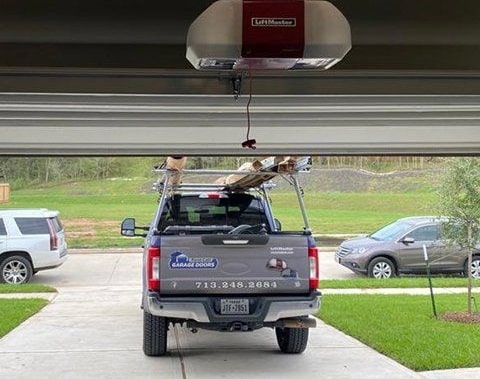Garage doors play a crucial role in both residential and commercial properties, serving as vital entrances. To ensure the safety of individuals and property, garage door sensors are essential components. These sensors prevent accidents by detecting obstacles and signaling the door opener to halt closing and reverse opening. However, if the sensors are not properly aligned, they may fail to function correctly, causing inconvenience and potential safety risks.
In this comprehensive guide, we will walk you through the process of aligning garage door sensors step-by-step. We will also provide an overview of what garage door sensors are, how they work, and common signs that indicate misalignment. By following our instructions, you can ensure that your garage door sensors are properly aligned and functioning optimally.
What Are Garage Door Sensors?
Garage door sensors, also known as safety reverse sensors, photo eye sensors, or safety eyes, are devices that detect objects in the path of a closing garage door and prevent accidents. They consist of two main components: an emitter and a receiver. The emitter sends out an infrared beam of light, while the receiver detects the presence of the beam. When an object interrupts the beam, the sensors signal the garage door opener to stop closing and reverse its direction.
Both residential and commercial garage doors require at least two sensors, with one placed on each side of the door’s track. This setup ensures that the sensors cover the entire width of the door’s path. By properly aligning these sensors, you can ensure that they function correctly and provide optimal safety.

How Garage Door Sensors Work
Garage door sensors rely on infrared technology to detect obstacles in the path of a closing door. The sender sensor emits an invisible beam of infrared light toward the receiver sensor on the opposite side of the door. As long as the receiver sensor detects the beam of light, the garage door is allowed to open and close. However, if the beam is interrupted by an object, the sensors immediately trigger the garage door opener to reverse its direction and prevent any accidents or damage.
The continuous communication between the sender and receiver sensors is crucial for proper functioning. If the sensors are misaligned, obstructed, or malfunctioning, the garage door may not operate correctly and can pose a safety risk.
Signs Your Garage Door Sensors Are Out of Alignment
Misaligned garage door sensors can lead to various issues and malfunctions. Here are some common signs that indicate your sensors may be out of alignment:
Blinking LED Lights on Door Sensors
One of the most noticeable signs of misalignment is when the LED lights on the door sensors are blinking or flickering. Normally, these lights should be steady and not blinking. If you observe any irregularities in the LED lights, it’s a clear indication that the sensors need to be realigned.
Garage Door Won’t Close
When your garage door repeatedly opens or fails to close completely, it may be due to misaligned sensors, necessitating professional garage door repair. The sensors are designed to detect obstacles and prevent the door from closing on them. If the sensors are misaligned, they may not detect objects properly, causing the door to reverse its direction or remain open.
Garage Door Signal Light Blinks and Flashes
If you notice that the signal light inside your garage blinks and flashes multiple times when attempting to close the door, it indicates a misalignment issue. The blinking light is a safety feature that alerts you to a potential problem with the sensors. In this case, realigning the sensors should resolve the issue.
How to Align Garage Door Sensors
Aligning garage door sensors is a relatively simple process that can be done by following a few steps. Here’s a step-by-step guide to help you align your garage door sensors correctly:
1. Close the Garage Door
Before you begin aligning the sensors, make sure the garage door is closed. If the door is not closing properly, you can hold down the close button until the door makes contact with the floor. This will prevent any unnecessary movement of the door while you work on the sensors.
2. Find and Inspect the Sensors
Locate the safety sensors on either side of the garage door, typically installed no higher than 6 inches off the ground. Take a closer look at the sensors and check for any dirt, debris, or obstructions that may be affecting their alignment. If you notice any buildup on the sensors, use a soft, damp cloth to clean them gently. Be careful not to scratch or damage the lens of the receiver sensor.
3. Align the Sensors
To align the sensors, follow these steps:
- Loosen the screws securing each sensor’s mounting bracket using a screwdriver. This will allow you to slide the brackets up and down.
- Slide one of the sensors down until it is no more than 6 inches off the floor. This is the maximum height the sensor should be positioned.
- Attach a string to the sensor you moved and tie it securely. Make sure the string is long enough to reach across the garage door to the other sensor.
- Slide the second sensor down to a similar height, using the string as a reference for alignment. Adjust the position of the sensor until it appears level with the first sensor.
- Once the sensors are aligned, tighten the screws on the mounting brackets to secure them in place.
- Double-check the alignment using a level to ensure that both sensors are properly aligned and level with each other.

Frequently Asked Questions
Here are some frequently asked questions about garage door sensors and their alignment:
Where can I find my garage door sensors?
Garage door sensors are typically located on either side of the garage door, no more than 6 inches off the ground. They are installed inside the garage, facing each other to cover the width of the door’s path.
Why is one sensor’s LED light green and the other orange?
Garage door sensors have two LED lights: a green light on the receiving sensor and an orange or red light on the sending sensor. The green light indicates that the receiving sensor is detecting the infrared light beam, while the orange or red light indicates that the sending sensor is emitting the beam.
Why do I have to hold my garage door button down to close it?
If you need to hold the garage door button down until the door closes, it suggests a problem with the safety sensors. Misaligned sensors can cause the door to reverse or not close properly. Aligning the sensors should resolve this issue.
Why is the signal light in my garage blinking when I try to close the door?
A blinking signal light indicates that there may be an object blocking the sensors or misalignment. Check for any obstructions and ensure that the sensors are properly aligned. Realignment should resolve the blinking light issue.
I realigned my sensors, but there’s still a problem. What should I do next?
If realigning the sensors or attempting other troubleshooting steps does not resolve the issue, it is recommended to contact a professional garage door repair technician. They can inspect the sensors, wiring, and overall setup to diagnose and fix any underlying problems.
How can I test my garage door sensors to see if they work properly?
To test your garage door sensors, open the garage door and place an object in the path between the sensors, such as a box or laundry basket. Try to close the garage door using the remote. If the sensors are aligned and working correctly, the door should stop closing and reverse its direction when it detects the object.

Conclusion
Aligning garage door sensors is a crucial step in ensuring the safe and proper operation of your garage door. By following the step-by-step guide outlined in this article, you can easily align the sensors and prevent potential accidents or malfunctions. Remember to regularly inspect and clean your sensors to maintain their optimal functionality. If you encounter any persistent issues, it is recommended to seek professional assistance. Stay safe and enjoy the hassle-free operation of your garage door!
Conclusion: Your first impulse is to call the best garage door repair company in the city. And if you live in Richmond, Texas, or anywhere nearby, that company is – First Call Garage Doors. Rest assured, we are first not just in name only, but also in the level and quality of our professional garage door repair services. Remember, when you call us, you’re not simply contacting us at First Call Garage Doors for help, you’re making the right call!
